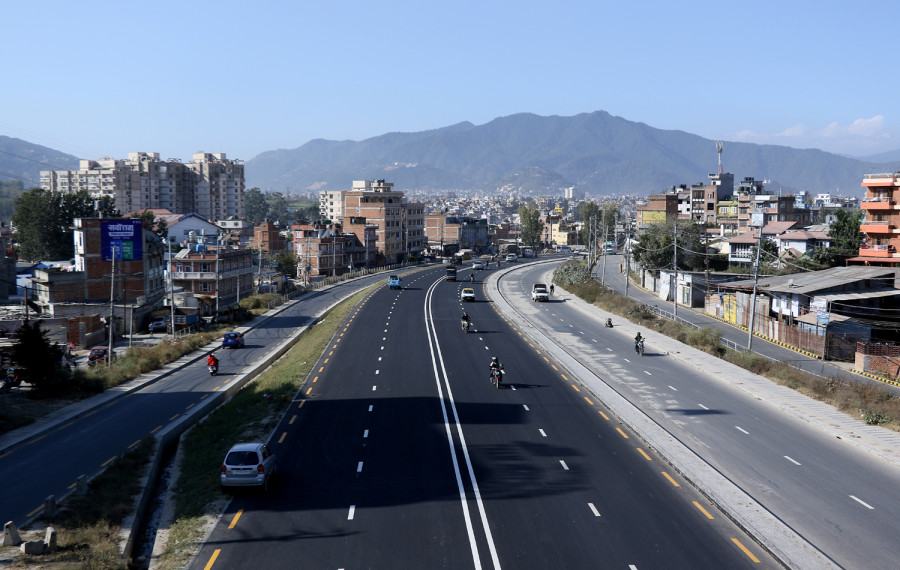Valley
New expressway turns killer: 9 killed in Koteshwor-Kalanki road section in 3 months
Twenty-year-old Smaran Maharjan was on way to his home in Thado Bharang, Swayambhu from Satdobato after seeing off his friend at the Tribhuvan International Airport on Friday evening when his motorbike collided with a car at Mahilaxmisthan while taking the middle path on the eight-lane road from a side lane.
Anup Ojha
Twenty-year-old Smaran Maharjan was on way to his home in Thado Bharang, Swayambhu from Satdobato after seeing off his friend at the Tribhuvan International Airport on Friday evening when his motorbike collided with a car at Mahilaxmisthan while taking the middle path on the eight-lane road from a side lane.
Maharjan sustained serious injury on his head. He was rushed to Ganeshman Singh Memorial Hospital that later referred him to Alka Hospital. He died there on Sunday.
Maharjan was a bachelor’s student at Soltimode-based College. He is one of the nine victims who died in road accidents at the newly built eight-lane Koteshwor-Kalanki Ring Road in the past three months.
“He was my only son. He had gone to see off his friend at the airport, but now he has left us forever,” said Smaran’s father, his eyes moist with grief.
The smooth and wide road from Kalanki to Koteshwor has proven to be a death trap for pedestrians, riders, and even traffic police say they are anxious when on duty in this area.
The lack of lane markings, zebra crossings, dividers, traffic lights, nightlights, and properly designated bus stops, are the main reasons for the accidents.
Metropolitan Traffic Police Range (MTPR), Lalitpur, Head Sitaram Hachhethu said, “Neither drivers nor pedestrians follow traffic rules here. Imagine the consequences when the road itself is unsafe.”
According to MTPR Lalitpur, in the past three months (July 16 to up to today) accidents claimed the lives of nine people and injured 172. MTPR’s data shows, last year 20 people died and 463 people sustained minor to major injuries in 684 accidents on this road. Talking to the Post, Hachhethu said, two traffic policemen were injured — one traffic constable fractured his leg and another injured his hand in the past three months.
“The road has become too risky because there are no traffic lights. The speed of many vehicles is so high that drivers lose control, it,” said Hachhethu.
Town planners, who find fault in the construction of the road, said the road was built in the mode of the expressway.
Urban Planner and former government secretary Kishor Thapa said, “If only the Department of Roads (DoR) had studied the design and corrected the flaws, we would not have to face these problems.”
A Chinese company Shanghai Construction Group Co Ltd was in charge of the 10.5km project since 2013. China had granted Rs 5.13 billion for the project.
The 10.5km section of the Ring Road has many intersections, namely: Balkhu, Sanepa, Ekantakuna, Gwarko, Satdobato, Balkumari that connect to the emerging cities. Every day hundreds of people cross the road that does not have zebra
crossings.
Kathmandu Ring Road Improvement Project (KRRIP) Engineer Niranjan Sharma said 95 percent of the construction work is complete.
“The Chinese company will not do anything more than what their contract stipulates. This is why the DoR has planned to construct six over head bridges costing Rs 200 million in Balkumari, Satdobato, Mahalaxmisthan, Ekantakuna, Sanepa, and Balkhu,” said Sharma.
At present, the Chinese government has constructed only three over-head bridges over the distance of three kms – at Koteshwor, in front of the B and B Hospital and, in Sanepa area. According to traffic police, the most accident-prone areas on the road section are; B&B Hospital area, Balkumari, Sanepa, and Kusanti Heights.
In the past three months, accidents claimed the lives of four people near B&B Hospital, three in Balkumari, and two in Sanepa.
Suggesting solutions, Thapa said, the accident rate could be reduced if the government adds traffic lights, median, zebra crossings, double dividers on the road, and planting trees on both sides of the road.
“The Nepal government can do with small investment. It should correct all flaws as soon as possible to minimise accident fatalities,” said Thapa.




 18.12°C Kathmandu
18.12°C Kathmandu.jpg)










